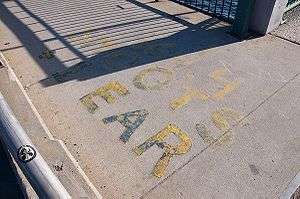Smoot
| Smoot | |
|---|---|
 In a photo dated 2009, the painted inscription reads "364.4 SMOOTS + 1 EAR". | |
| Unit information | |
| Named after | Oliver R. Smoot |
| Unit conversions | |
| 1 smoot in ... | ... is equal to ... |
| imperial/US units | 5 ft 7 in |
| SI units | 1.702 m |
The smoot /ˈsmuːt/ is a nonstandard, humorous unit of length created as part of an MIT fraternity prank. It is named after Oliver R. Smoot, a fraternity pledge to Lambda Chi Alpha, who in October 1958 lay down repeatedly on the Harvard Bridge (between Boston and Cambridge, Massachusetts) so that his fraternity brothers could use his height to measure the length of the bridge.[1]
Unit description

One smoot is equal to Oliver Smoot's height at the time of the prank, 5 feet 7 inches (1.70 m).[2] The bridge's length was measured to be 364.4 smoots (2,035 ft; 620.1 m) plus or minus one ear, with the "plus or minus" intended to express uncertainty of measurement.[3] Over the years the "or minus" portion has gone astray in many citations, including the markings at the site itself, but has now been enshrined in stone by Smoot's college class.[4]
History
To implement his use as a unit of measure, Oliver Smoot repeatedly lay down on the bridge, let his companions mark his new position in chalk or paint, and then got up again. Eventually, he got tired from all this exercise and was carried thereafter by the fraternity brothers to each new position.[5][6]
Oliver Smoot graduated from MIT with the class of 1962, became a lawyer, and later became chairman of the American National Standards Institute (ANSI, 2001–02)[7] and then, president of the International Organization for Standardization (ISO, 2003–04).[8] He is the cousin of Nobel Prize winner George Smoot. The prank's fiftieth anniversary was commemorated on October 4, 2008 as Smoot Celebration Day at MIT, which Smoot attended.[6]
In 2011, "smoot" was one of the 10,000 new words added to the fifth edition of the American Heritage Dictionary.[9][10]
On May 7, 2016, Oliver Smoot served as Grand Marshal of the alumni parade across the bridge, celebrating the 100th anniversary of MIT's move from Boston to Cambridge.[11]
Practical use

The bridge is marked with painted markings indicating how many smoots there are from where the sidewalk begins on the Boston river bank. The marks are repainted each semester by the incoming associate member class (similar to pledge class) of Lambda Chi Alpha.[12]
Markings typically appear every 10 smoots, but additional marks appear at other numbers in between. For example, the 70-smoot mark is accompanied by a mark for 69. The 182.2-smoot mark is accompanied by the words "Halfway to Hell" and an arrow pointing towards MIT. Each class also paints a special mark for their graduating year.
The markings have become well accepted by the public, to the degree that during the bridge renovations that occurred in the 1980s, the Cambridge Police department requested that the markings be maintained by Lambda Zeta, the MIT chapter of Lambda Chi Alpha which created and maintains the smoot markings, since they had become useful for identifying the location of accidents on the bridge.[13] The renovators went one better, scoring the concrete surface of the sidewalk on the bridge at 5 foot 7 inch intervals, instead of the conventional six feet.[14] The markings continue to be maintained once or twice annually by the undergraduates and alumni of Lambda Zeta.
Google Calculator also incorporates smoots, which it reckons at exactly 67 inches (170.18 cm).[2] Google also used the smoot as an optional unit of measurement in their Google Earth software and Google Maps distance measurement tool.[15] In 2014, Google introduced a new Maps interface with a measurement tool that gives distances only in feet/miles and meters/kilometers.
MIT's student-run college radio station, WMBR, broadcasts at a wavelength of 2 smoots (88.1 MHz).[16]
See also
References
- ↑ Curran, Susan. "Spotlight: A salute to Smoot". Massachusetts Institute of Technology. Retrieved 13 August 2015.
- 1 2 Google: "1 smoot in meters"
- ↑ Tavernor, Robert, Smoot's Ear: The Measure of Humanity, Yale University Press (2007), ISBN 978-0-300-12492-7, Preface, pp. xi-xvi
- ↑ "Smoot in Stone". MIT News. Cambridge, Massachusetts: Massachusetts Institute of Technology. 2009-06-04. Retrieved 2010-07-20.
Specifically noting the bridge's length of 364.4 Smoots (+/- 1 ear), the plaque, a gift of the MIT Class of 1962, honors the prank's 50th anniversary.
- ↑ Kostoulas, Andy (1999-10-12). "This Month In MIT History". The Tech. Retrieved 2009-04-18.
- 1 2 Smoot Day on October 4, 2008
- ↑ Oliver R. Smoot
- ↑ MIT - a salute to Smoot Archived 2015-06-20 at the Wayback Machine.
- ↑ Cornish, Audie (2011-11-13). "Looking Up Words In A Book Not So Strange Yet". National Public Radio. Retrieved 10 December 2012.
- ↑ "American Heritage Dictionary entry". American Heritage Dictionary. Houghton Mifflin Harcourt Publishing Company. Retrieved 10 December 2012.
- ↑ Fleming, Nicole (May 7, 2016). "By land and by water, MIT celebrates 100 years in Cambridge". Boston Globe. Retrieved 9 May 2016.
- ↑ Historic American Engineering Record (HAER) (1987). Harvard Bridge, Spanning Charles River at Massachusetts Avenue, Boston, Suffolk County, MA. Philadelphia, Pennsylvania: Department of the Interior. p. 5. http://hdl.loc.gov/loc.pnp/hhh.ma1293. Retrieved 2009-05-12.
- ↑ Keyser describes his top five hacks - MIT News Office
- ↑ Fahrenthold, David A. "The Measure of This Man Is in the Smoot". The Washington Post. Retrieved 2010-05-23.
- ↑ Google Maps distance measurement tool
- ↑ Wolfram|Alpha Can't, 13 Jun 2017
External links
- The Smoot as a unit of length
- "smoot". Sizes.com. Retrieved 8 July 2010.
- The Smoot story, in Oliver Smoot's own words
- MIT Museum article, with photos at the Wayback Machine (archived August 6, 1997)
- A December, 2005 National Public Radio Interview with Oliver Smoot upon his retirement.
- What's A Smoot? NPR.org
